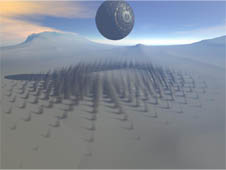|
Source:
http://www.fnal.gov/pub/inquiring/questions/higgs_boson.html
You need to distinguish between the Higgs boson and the Higgs
field. The Higgs field is the stuff that gives all other particles a mass.
Every particle in our universe "swims" through this Higgs field. Through
this interaction every particle gets its mass. Different particles interact
with the Higgs field with different strengths, hence some particles are
heavier (have a larger mass) than others. (Some particles have no mass. They
don't interact with the Higgs field; they don't feel the field.) It is the
opposite of people swimming in water. As people float in water they "become"
lighter. Depending on size, shape, etc, some people float better than
others.
The Higgs field is not considered a force. It cannot accelerate
particles, it doesn't transfer energy. However, it interacts universally
with all particles (except the massless ones), providing their masses.
The Higgs boson is a particle. It gets its mass like all other
particles: by interacting with ("swimming in") the Higgs field. But as you
can imagine, the Higgs particle differs from all the other particles we
know. It can be thought of a dense spot in the Higgs field, which can travel
like any other particle. Like a drop of water in water vapor.
The Higgs boson has many more ways of interacting with all
other kinds of particles than the Higgs field (which just causes a "drag" =
mass). In this sense one my call the Higgs particle the mediating particle
of the proposed Higgs field, like you wrote. The Higgs field is the silent
field that gives the mass. We cannot directly probe for it. But discovering
the Higgs boson, the "mediator", would prove the existence of the Higgs
field.
The Higgs particle, like many other elementary particles, is
not a stable particle. Since it interacts with all kinds of other massive
particles it can be created in collisions. (The Higgs particle does not
interact with massless particles, such as a photon or a gluon. Since these
particles don't interact with the Higgs field, the Higgs boson also doesn't
interact with them.)
Once the Higgs particle has been created, it will eventually
decay. Though the Higgs particle interacts with all massive particles it
prefers to interact with the heaviest elementary particles we know,
especially the top quark, which was discovered at Fermilab in 1995. Because
of this property of the Higgs boson physicists at Fermilab might have a
chance to find evidence for the Higgs boson itself within the next five to
six years. If they are not successful then an accelerator currently build at
the CERN laboratory in Geneva, Switzerland, will have enough energy to
produce the Higgs boson. Fermilab's accelerator currently is the world's
most powerful accelerator, but physicists don't know whether it has enough
power to create Higgs bosons. The new accelerator at CERN will have more
power, but construction won't be finished until 2005.
The Higgs particle is considered to be a carrier of a force. It
is a boson, like the other force-transferring particles: photons, gluons,
electroweak bosons. One may call the force mediated by the Higgs boson to be
universal as the Higgs boson interacts with all kinds of massive particles,
no matter whether they are quarks, leptons, or even massive bosons (the
electroweak bosons). Only photons and gluons do not interact with the Higgs
boson. Neutrinos, the lightest particles with almost zero mass, barely
interact with a Higgs boson. Top quarks, which have about the mass of a Gold
atom, have the strongest interaction with a Higgs boson.
For further reading I recommend two books:
Popular science reading: L. Lederman, The God Particle
Scientific reading: S. Dawson et al., The Higgs Hunter's Guide
|

